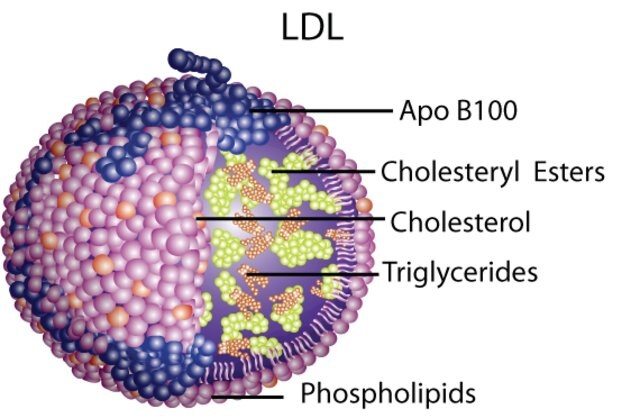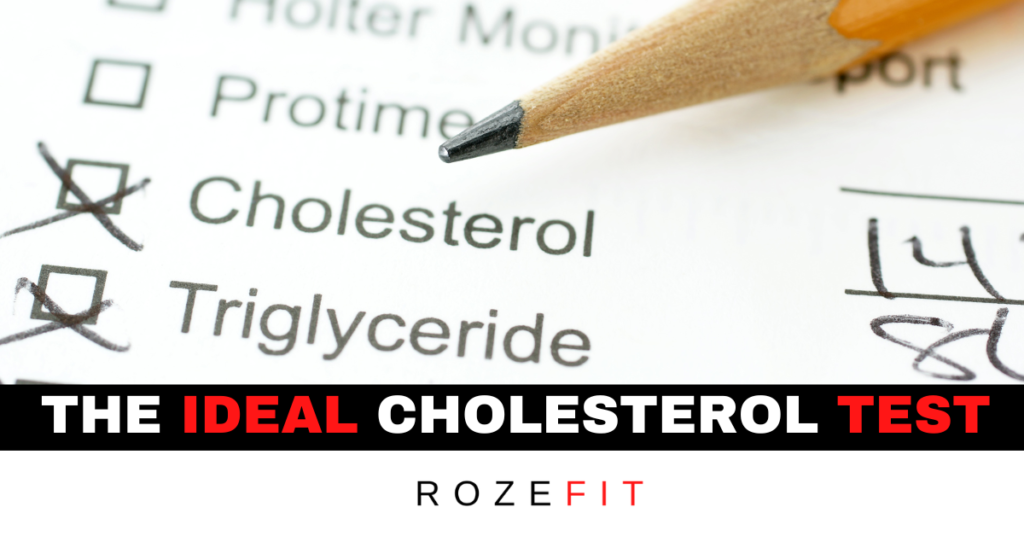When you go to your doctor, and they draw your blood to get insight into your lipid profile, you are more than likely going to be given the following metrics:
1.) Total Cholesterol
2.) HDL Cholesterol
3.) LDL Cholesterol
4.) Non-HDL Cholesterol
5.) Triglycerides
And while this basic lipid profile gives you some insight into cardiovascular risk, it is not the best assay to assess risk by.
This article will investigate the importance of measuring the apoB-100 particle as the preferred metric for assessing cardiovascular risk.
What Is Cholesterol in the First Place?
On its most basic level, cholesterol is an organic molecule called a lipid.
It is hydrophobic, meaning it repels water.
Cholesterol is used for making the cell membranes found in every cell of your body.
It also synthesizes hormones like cortisol, estrogen, testosterone, etc.
Interestingly, most of the cholesterol contained in the plasma of your blood is made by your body.
Very little of it comes from the food you consume because it is too large of a molecule for your gut to absorb.
Cholesterol Transport

Because cholesterol is hydrophobic, it needs a vehicle to transport it throughout the body.
And the way your body moves things around is through your circulatory system.
The circulatory system is made up of blood and plasma.
So cholesterol is packaged in something called a lipoprotein, which is a spherical molecule that can be transported through the circulatory system.
Lipoprotein Families
These lipoproteins are categorized by two families:
1.) The apoB family
2.) The apoA family
The apoB family is defined by the following lineage of particles:
VLDL (very low-density lipoproteins)
IDL (intermediate density lipoproteins)
LDL (very low-density lipoproteins)
Lp(a) (another type of lipoprotein)
As you can see, each is defined by its density.
The apoA family is defined by the HDL lineage, which we won’t get into here – but just understand that the two lipoprotein families are apoB and apoA.
The apoB Family

The apoB family consists of the four types of lipoproteins mentioned above, and these are precisely the particles that carry the most atherogenic risk.
You have probably heard at some point that LDL is the “bad cholesterol.”
And that’s because the low-density lipoproteins are the ones that can make their way into the artery wall and wreak havoc.
The apoB-100 is a signature protein on the LDL particle that is responsible for its organization.
It also acts as a ligand for all of the LDL receptors in your body.
It basically acts as a key for the LDL particle to bind with the LDL receptor.
These LDL receptors are responsible for uptaking the cholesterol contained within the particle and using it for whatever function is needed by the cell.
The problem is, sometimes the apoB particle delivers cholesterol to the artery wall and that certainly is not good.
But, the good news is – we can measure this apoB particle.
And if we can measure how many of these particles you have floating around in your plasma, we can assess your cardiovascular risk.
More particles = greater risk.
Why Measuring apoB Matters

When you go to the doctor and they do a standard lipid panel, they are measuring LDL-C which is the concentration of the LDL cholesterol contained in your plasma (mg/dL).
It tells you nothing about particle number because concentration is a mass per volume measurement.
The evidence is abundantly clear that the NUMBER of LDL particles is a greater predictor of risk.
The more particles there are, the more chances there are for those particles to interact with the artery wall and potentially get trapped inside the artery wall.
You can see an example of this in the figure above.
This of course is what causes the cascading effect of atherosclerotic cardiovascular disease.
I’ve written in depth about this.
The Real Kicker
Here it is.
Since there is only one apoB-100 molecule per lipoprotein, the number of particles is reflected by the apoB-100 concentration.
It is a great proxy measurement for particle number.
Since LDL particle number is the best greater predictor of risk, you get a more accurate assessment of risk by measuring apoB.
It is essentially capturing the sum total of the atherogenic particles that could make their way into your artery wall.
All you really need to determine your burden of risk is measure the apoB particle.
ApoB is Better Than LDL-C
More evidence points to the fact that apoB is a more accurate measurement to assess risk than LDL-C alone.
That’s because there is often discordance between apoB and LDL-C.
Bob Lee demonstrated this in his paper which showed that the number of LDL particles had no relation to plasma triglyceride or cholesterol concentration.
The next time you visit the doctor, ask them to measure your apoB.
It will give you much better insight into your cardiovascular risk than a standard lipid panel.
If they ask you why – point them to the work of Allan Sniderman, Tom Dayspring, and Ron Krauss.
Arguably the world’s greatest Lipidologists that have demonstrated the superior nature of the apoB assay!
Take Your Health Seriously

Aside from establishing a relationship with a team of physicians that will keep a close eye on your health, I highly recommend hiring a personal trainer to keep you accountable.
Exercise is one of the best tools we have for increasing healthspan.
Make it a consistent part of your life and work with a qualified coach who will take your needs seriously and help you improve your health through movement and diet.
I have worked with some of the world’s top performing individuals in their line of professional work and I would be happy to show up for you as your personal trainer as well.
You can get a hold of me at jakob@rozefit.com.
I look forward to hearing from you.

